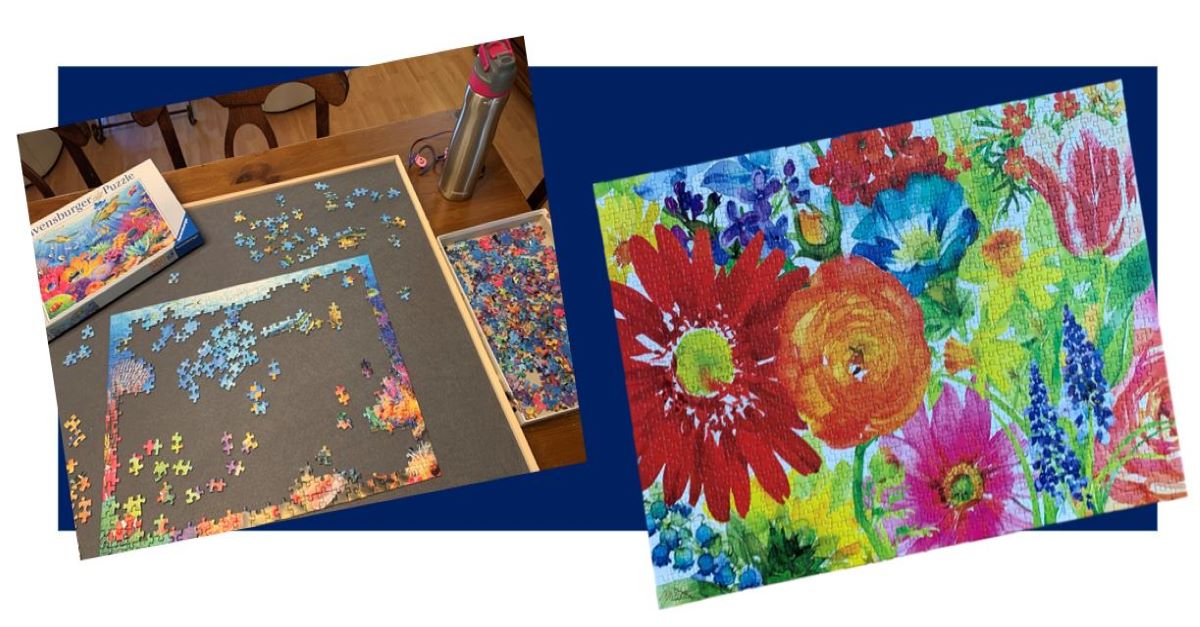I never understood the allure of jigsaw puzzles.
Until now. At first, I tiptoed into it, with the purchase of one puzzle I thought for sure my grown-and-flown-and-then-back-again young adult sons would enjoy helping me solve. It was a gorgeous 1,000-piecer of a small town built into the mountains at the ocean’s edge in Italy — one my oldest son visited while studying abroad. And yes, he and his younger brother actually sat for 5 minutes from time to time while wandering out of the kitchen to fit some pieces into the emerging picture.
It was a lot harder than I imagined.
That gorgeous blue sky that met the water at the imperceptible horizon? Something to marvel at in life (and in pics) — but to reconstruct as a puzzle? That was an awful lot of blue in an awful lot of small pieces!
That first puzzle was so tough. And so satisfying. I was immersed, mesmerized, you might even say obsessed. I spent hours at the dining room table over cold winter weekends and late into the night, head bent, fingers sorting pieces first by color and then by shape. It got so that I was literally dreaming about shapes and colors. For real. I was hooked. As soon as that one was finished, three more fell into my shopping cart.
I have since developed some discipline concerning how much time I spend at what is now officially known as the puzzle table. (And since we do occasionally use the table for dining per its initial intention, I even invested in a puzzle table thingy with drawers for sorting that I can move about as needed.)
Lesson #1: Walk away
Like any good project with a ton of details, you can so easily get lost in the minutiae. You say to yourself — just this one more piece, that will be so satisfying. But you just can’t seem to find that piece. And another one catches your eye, and you know just where it goes! And then all of a sudden, it’s 8:20 pm, your stomach is growling and you realize that no one has given a thought to the evening meal.
So now, I give myself a limit before I sit down — it could be the 10-minute break between Zoom calls (see Lesson #2) or however long it takes to eat the peanut butter and banana sandwich for lunch, or the 15 minutes the dinner that someone actually thought of (and did something about) is cooking.
The point is: Get up and walk away. There are simply some situations in life that can’t be solved in one sitting. The quicker you realize that, the less time you waste in utter frustration. Just stand up and leave the scene. It is an amazingly cleansing action. Even when you don’t feel like it,
Do it Anyway!
Lesson #2: We can all use a bit of mental floss from time to time
Who among us hasn’t endured hours and hours of video calls over the past year? There’s been so much reported recently about how mentally demanding these interactions can be. For me, the word is INTENSE. I find myself listening and watching harder than I do on audio only or even in person. It’s like something in me is terrified to miss a single syllable or nuance. And it’s exhausting.
During several recent all-day training sessions, I found myself grabbing a cup of tea and sitting down at the puzzle table during my 10-minute breaks. It was like going from a several-hour, multi-sensory experience into a quiet, padded room. The space and quiet and relative mindlessness of pushing around colorful puzzle pieces on a grey felt board was meditative. It was like an invitation to take a deep breath, let go of any mental focus and truly relax the brain. Which seems to me to be a helpful thing to do when trying to solve a complex problem.
Lesson #3: The picture in your head doesn’t always match reality
Somewhere along the line, I learned to work on sections. It’s incredibly satisfying to fit pieces together based on color and shape, even though you don’t yet know where it all goes into the bigger picture (see Lesson #4).
Then there comes the moment where that section starts to resemble a thing. And you start to get a sense — even a knowing — about where it goes. So you continue building, sure you know just where and how it will fit.
But for some reason, it just doesn’t. Fit, that is. It’s like you can see this section as an extension of the picture emerging along the frame — but something’s wrong. You begin to wonder if some pieces were left out of your box. And then you get up and walk away (remember Lesson #1?).
That’s when you loosen your grip on how you
thought that section should fit. When you return, you spin the entire section around and discover that what you thought was up is actually down. (Seriously, this has happened to me more than once.)
I find this the toughest of the 4 lessons because it leans heavily on humility; as in, well — maybe I
don’t have all the answers after all! Where in your life might you benefit from loosening your grip on how you
think things should look? What if you spun things around or consciously let that preconceived notion float off — even for a few minutes? What might appear in its place?
(Check out
this post for a super easy, fast and fun exercise to see how your perspective works.)
Lesson #4: Sometimes you have to zoom in and sometimes you have to zoom out (and sometimes you have to do both)
I figured this last puzzle would be a breeze; after all, it’s a mere 500 pieces and a seemingly basic aquarium scene. Two or three sessions in, I started depositing elements of the big turtle into a corner to sort through later. One day, I noticed that the turtle pile had grown larger than the rest of the unused pieces. How could that be? It was just one turtle! That’s when I took a closer look at the picture on the box and discovered
seven turtles! All with the same drab green and beige coloring! Whoa. How did I miss that?
In our change work with large organizations, we often talk about the need to zoom in and zoom out, sometimes at the same time. It’s like having one eye on the detail and one eye on the big picture simultaneously. As I discovered at my dining room (er, puzzle) table: The outcome of any real-life scenario is better when neither viewpoint is considered in a vacuum.
Schedule a Complimentary Clarity Call with me today to reveal where you might benefit from shifting your perspective.





